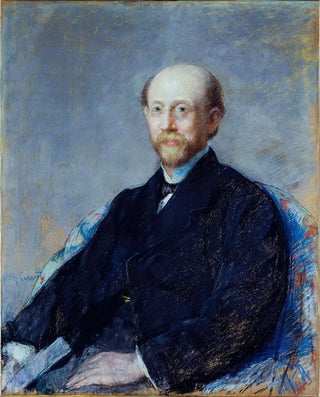Art print | Portrait of a man - Mary Cassatt Source: Reproduction | Portrait d'homme - Mary Cassatt


View from behind

Frame (optional)
Portrait of a Man - Mary Cassatt – Captivating Introduction
The "Portrait of a Man" by Mary Cassatt is a work that captures attention and invites contemplation. This painting, created by one of the most iconic figures of the Impressionist movement, reveals a complex personality that is both intimate and universal. Through her delicate brushstrokes and subtle palette, Cassatt manages to convey a palpable emotion, making this art print not only a testament to her era but also an exploration of human relationships. The piece stands out for its ability to capture the very essence of its subject, offering the viewer a window into the soul of the depicted man.
Style and uniqueness of the work
Mary Cassatt, although often associated with portraits of women and family scenes, demonstrates in this art print a mastery of technique and a keen sense of observation. The artist's Impressionist style is expressed through the use of soft lights and nuanced colors, creating a warm and welcoming atmosphere. The composition is carefully balanced, with each element chosen to enhance the visual and emotional impact of the work. The way Cassatt plays with shadows and lights adds unprecedented depth to the face of the man, while the blurred background helps to emphasize the main subject. This stylistic choice accentuates the intimacy of the portrait, making each gaze a suspended moment in time.
The artist and her influence
Mary Cassatt, born in 1844, was a pioneer of the Impressionist movement, distinguished by her unique approach and her commitment to representing women and everyday life. Her collaboration with artists such as Edgar Degas helped shape her style and refine her aesthetic sense. Cassatt always sought to give a voice to women, both in her subjects and in her artistic approach. Her influence extends beyond her era, inspiring generations of artists to explore similar themes. By incorporating elements of modern life into her works, she paved the way for a new vision of art, where the individual and their emotions are at the heart of creation. The "Portrait of a Man" fits into this lineage, bearing witness to her exceptional talent and

Matte finish

View from behind

Frame (optional)
Portrait of a Man - Mary Cassatt – Captivating Introduction
The "Portrait of a Man" by Mary Cassatt is a work that captures attention and invites contemplation. This painting, created by one of the most iconic figures of the Impressionist movement, reveals a complex personality that is both intimate and universal. Through her delicate brushstrokes and subtle palette, Cassatt manages to convey a palpable emotion, making this art print not only a testament to her era but also an exploration of human relationships. The piece stands out for its ability to capture the very essence of its subject, offering the viewer a window into the soul of the depicted man.
Style and uniqueness of the work
Mary Cassatt, although often associated with portraits of women and family scenes, demonstrates in this art print a mastery of technique and a keen sense of observation. The artist's Impressionist style is expressed through the use of soft lights and nuanced colors, creating a warm and welcoming atmosphere. The composition is carefully balanced, with each element chosen to enhance the visual and emotional impact of the work. The way Cassatt plays with shadows and lights adds unprecedented depth to the face of the man, while the blurred background helps to emphasize the main subject. This stylistic choice accentuates the intimacy of the portrait, making each gaze a suspended moment in time.
The artist and her influence
Mary Cassatt, born in 1844, was a pioneer of the Impressionist movement, distinguished by her unique approach and her commitment to representing women and everyday life. Her collaboration with artists such as Edgar Degas helped shape her style and refine her aesthetic sense. Cassatt always sought to give a voice to women, both in her subjects and in her artistic approach. Her influence extends beyond her era, inspiring generations of artists to explore similar themes. By incorporating elements of modern life into her works, she paved the way for a new vision of art, where the individual and their emotions are at the heart of creation. The "Portrait of a Man" fits into this lineage, bearing witness to her exceptional talent and






